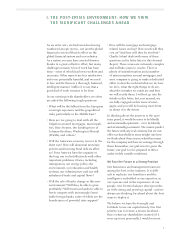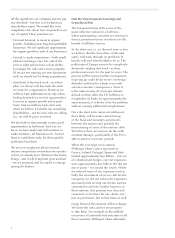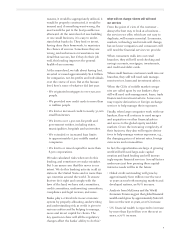JP Morgan Chase 2010 Annual Report Download - page 17
Download and view the complete annual report
Please find page 17 of the 2010 JP Morgan Chase annual report below. You can navigate through the pages in the report by either clicking on the pages listed below, or by using the keyword search tool below to find specific information within the annual report.-
 1
1 -
 2
2 -
 3
3 -
 4
4 -
 5
5 -
 6
6 -
 7
7 -
 8
8 -
 9
9 -
 10
10 -
 11
11 -
 12
12 -
 13
13 -
 14
14 -
 15
15 -
 16
16 -
 17
17 -
 18
18 -
 19
19 -
 20
20 -
 21
21 -
 22
22 -
 23
23 -
 24
24 -
 25
25 -
 26
26 -
 27
27 -
 28
28 -
 29
29 -
 30
30 -
 31
31 -
 32
32 -
 33
33 -
 34
34 -
 35
35 -
 36
36 -
 37
37 -
 38
38 -
 39
39 -
 40
40 -
 41
41 -
 42
42 -
 43
43 -
 44
44 -
 45
45 -
 46
46 -
 47
47 -
 48
48 -
 49
49 -
 50
50 -
 51
51 -
 52
52 -
 53
53 -
 54
54 -
 55
55 -
 56
56 -
 57
57 -
 58
58 -
 59
59 -
 60
60 -
 61
61 -
 62
62 -
 63
63 -
 64
64 -
 65
65 -
 66
66 -
 67
67 -
 68
68 -
 69
69 -
 70
70 -
 71
71 -
 72
72 -
 73
73 -
 74
74 -
 75
75 -
 76
76 -
 77
77 -
 78
78 -
 79
79 -
 80
80 -
 81
81 -
 82
82 -
 83
83 -
 84
84 -
 85
85 -
 86
86 -
 87
87 -
 88
88 -
 89
89 -
 90
90 -
 91
91 -
 92
92 -
 93
93 -
 94
94 -
 95
95 -
 96
96 -
 97
97 -
 98
98 -
 99
99 -
 100
100 -
 101
101 -
 102
102 -
 103
103 -
 104
104 -
 105
105 -
 106
106 -
 107
107 -
 108
108 -
 109
109 -
 110
110 -
 111
111 -
 112
112 -
 113
113 -
 114
114 -
 115
115 -
 116
116 -
 117
117 -
 118
118 -
 119
119 -
 120
120 -
 121
121 -
 122
122 -
 123
123 -
 124
124 -
 125
125 -
 126
126 -
 127
127 -
 128
128 -
 129
129 -
 130
130 -
 131
131 -
 132
132 -
 133
133 -
 134
134 -
 135
135 -
 136
136 -
 137
137 -
 138
138 -
 139
139 -
 140
140 -
 141
141 -
 142
142 -
 143
143 -
 144
144 -
 145
145 -
 146
146 -
 147
147 -
 148
148 -
 149
149 -
 150
150 -
 151
151 -
 152
152 -
 153
153 -
 154
154 -
 155
155 -
 156
156 -
 157
157 -
 158
158 -
 159
159 -
 160
160 -
 161
161 -
 162
162 -
 163
163 -
 164
164 -
 165
165 -
 166
166 -
 167
167 -
 168
168 -
 169
169 -
 170
170 -
 171
171 -
 172
172 -
 173
173 -
 174
174 -
 175
175 -
 176
176 -
 177
177 -
 178
178 -
 179
179 -
 180
180 -
 181
181 -
 182
182 -
 183
183 -
 184
184 -
 185
185 -
 186
186 -
 187
187 -
 188
188 -
 189
189 -
 190
190 -
 191
191 -
 192
192 -
 193
193 -
 194
194 -
 195
195 -
 196
196 -
 197
197 -
 198
198 -
 199
199 -
 200
200 -
 201
201 -
 202
202 -
 203
203 -
 204
204 -
 205
205 -
 206
206 -
 207
207 -
 208
208 -
 209
209 -
 210
210 -
 211
211 -
 212
212 -
 213
213 -
 214
214 -
 215
215 -
 216
216 -
 217
217 -
 218
218 -
 219
219 -
 220
220 -
 221
221 -
 222
222 -
 223
223 -
 224
224 -
 225
225 -
 226
226 -
 227
227 -
 228
228 -
 229
229 -
 230
230 -
 231
231 -
 232
232 -
 233
233 -
 234
234 -
 235
235 -
 236
236 -
 237
237 -
 238
238 -
 239
239 -
 240
240 -
 241
241 -
 242
242 -
 243
243 -
 244
244 -
 245
245 -
 246
246 -
 247
247 -
 248
248 -
 249
249 -
 250
250 -
 251
251 -
 252
252 -
 253
253 -
 254
254 -
 255
255 -
 256
256 -
 257
257 -
 258
258 -
 259
259 -
 260
260 -
 261
261 -
 262
262 -
 263
263 -
 264
264 -
 265
265 -
 266
266 -
 267
267 -
 268
268 -
 269
269 -
 270
270 -
 271
271 -
 272
272 -
 273
273 -
 274
274 -
 275
275 -
 276
276 -
 277
277 -
 278
278 -
 279
279 -
 280
280 -
 281
281 -
 282
282 -
 283
283 -
 284
284 -
 285
285 -
 286
286 -
 287
287 -
 288
288 -
 289
289 -
 290
290 -
 291
291 -
 292
292 -
 293
293 -
 294
294 -
 295
295 -
 296
296 -
 297
297 -
 298
298 -
 299
299 -
 300
300 -
 301
301 -
 302
302 -
 303
303 -
 304
304 -
 305
305 -
 306
306 -
 307
307 -
 308
308
 |
 |

15
The WaMu Acquisition: A Bit Worse than Expected but Clearly Still Worth It
With more than two years’ perspective, I’d like to
take a look back at how we did with the acquisition
of Washington Mutual — particularly relative to how
we thought the deal would play out at the time of
the acquisition.
WaMu’s ongoing operating earnings were
approximately what we expected — but not in
the way we expected
When we completed the WaMu acquisition on
September 25, 2008, we thought it was financially
compelling and immediately accretive to earn-
ings, though clearly not without risk. We acquired
WaMu’s 2,200 branches, 5,000 ATMs and 12.6
million checking accounts, as well as savings,
mortgage and credit card accounts. At that time,
we estimated that it would add $3 billion to 2010
net income.
The chart above shows what we said would happen
over time vs. what actually happened. These
numbers do not include one-time gains or losses,
which I describe in the following paragraph. In
the numbers above, the mortgage origination and
servicing business did better than expected, mostly
due to higher volumes and spreads. And the retail
business did significantly worse, mostly due to
curtailing fees on nonsucient funds and over-
drafts. We expect the business to perform in the
future as we originally thought.
One-time, after-tax gains and losses are a
negative and still could get slightly worse
When we acquired WaMu, we acquired approxi-
mately $240 billion of mortgage and credit card
loans, which we immediately wrote down by $30
billion. We knew when we did the transaction that
the depth and severity of the recession in the
housing market could drive mortgage losses even
higher than our estimates (which, at the time, we
thought were conservative). We thought losses
could wind up being $10 billion worse (pretax), and
we have experienced about half of that. We antici-
pate some further potential downside, depending
on the health of the U.S. economy, as well as some
other one-time gains and losses relating to litiga-
tion and other unresolved matters. The heritage
WaMu credit card business essentially is liquidating
with approximately the results we expected.
The WaMu acquisition has created future
opportunities that we would not have had if
we did not do this acquisition — and these are
better than we anticipated
The expansion of our Middle Market Commercial
Banking business, within the WaMu footprint,
which we are managing and growing carefully, can
deliver more than $500 million in pretax profits
annually, though this could take more than five
years. And the Commercial Term Lending Busi-
ness, which essentially is making mortgage loans
on multifamily houses — a business we previously
didn’t know very well — also will be able to grow
its earnings to more than $500 million a year —
significantly better than we expected. We think the
Small Business Banking opportunity is even larger
than we thought and could be as much as $1 billion
pretax annually over the long term.
One-Time Items (After-Tax)
Operating Earnings, Excluding One-Time Items
(in billions)
Initial
Expectations Actual
2009 $2.4 $2.8
2010 3.0 2.7
2011 3.4 3.1 *
15
